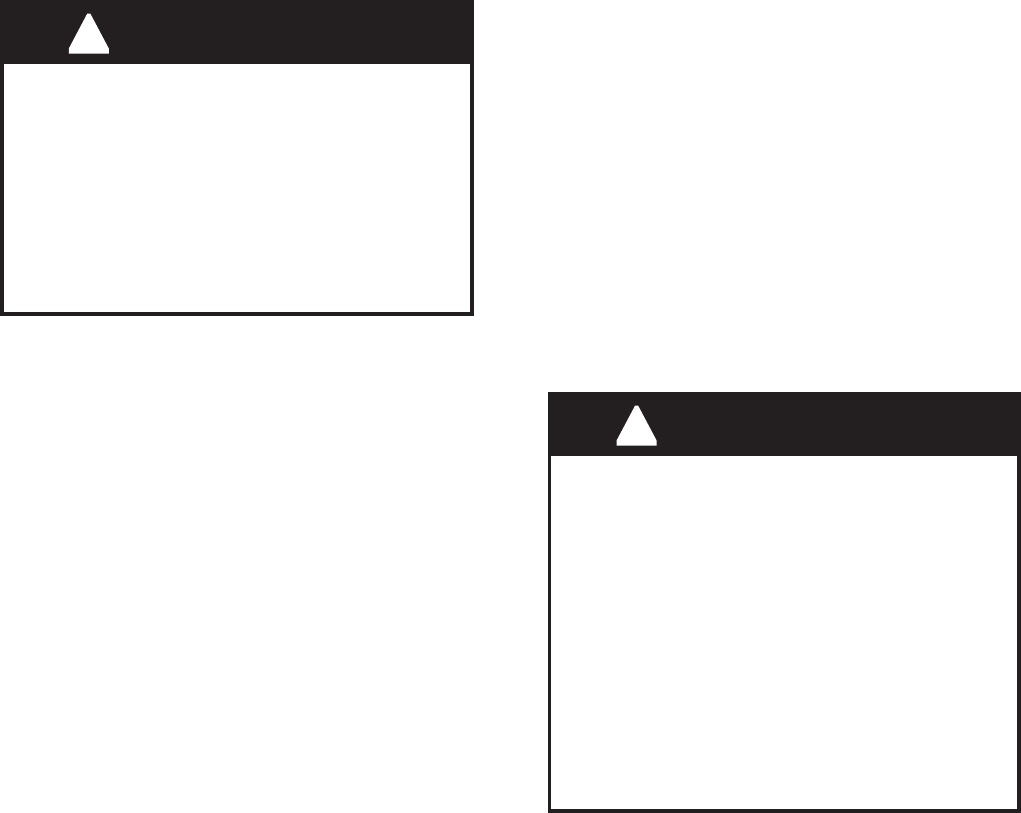
Version Hi-Lo 02/04 - Page 2
VENTING REQUIREMENTS
Determine which venting method is best for your applica-
tion. Ductwork can extend either through the wall or the
roof.
The length of the ductwork and the number of elbows
should be kept to a minimum to provide efficient perfor-
mance. The size of the ductwork should be uniform. Do
not install two elbows together. Use duct tape to seal all
joints in the ductwork system. Use caulking to seal exterior
wall or floor opening around the cap.
Flexible ductwork is not recommended. If it is used,
each foot of flexible ductwork used is equivalent to
two feet of straight metal ductwork when calculating
the ductrun length. Thus, a flexible elbow equals two
standard elbows.
Make sure there is proper clearance within the wall or floor
for exhaust duct before making cutouts. Do not cut a joist
or stud unless absolutely necessary. If a joist or stud must
be cut, then a supporting frame must be constructed.
FOR MORE SPECIFIC DUCTWORK INFORMATION,
GO TO PAGE 5.
WARNING - To Reduce The Risk Of Fire, Use Only
Metal Ductwork.
ELECTRICAL REQUIREMENTS
A 120 volt, 60 Hz AC-only electrical supply is required on
a separate 15 amp fused circuit. A time-delay fuse or
circuit breaker is recommended. The fuse must be sized
per local codes in accordance with the electrical rating of
this unit as specified on the serial/rating plate located
inside the unit near the field wiring compartment. THIS
UNIT MUST BE CONNECTED WITH COPPER WIRE
ONLY. Wire sizes must conform to the requirements of the
National Electrical Code, ANSI/NFPA 70 - latest edition,
and all local codes and ordinances. Wire size and connec-
tions must conform with the rating of the appliance. Copies
of the standard listed above may be obtained from:
National Fire Protection Association
Batterymarch Park
Quincy, Massachusetts 02269
• Venting system MUST terminate outside the
home.
• DO NOT terminate the ductwork in an attic or
other enclosed space.
• DO NOT use 4" laundry-type wall caps.
• Flexible-type ductwork is not recommended.
• DO NOT obstruct the flow of combustion and
ventilation air.
• Failure to follow venting requirements may
result in a fire.
This appliance should be connected directly to the fused
disconnect (or circuit breaker) through flexible, armored or
nonmetallic sheathed copper cable. Allow some slack in
the cable so the appliance can be moved if servicing is ever
necessary. A UL Listed, 1/2" conduit connector must be
provided at each end of the power supply cable (at the
appliance and at the junction box).
When making the electrical connection, cut a 1 1/4" hole
in the wall. A hole cut through wood must be sanded until
smooth. A hole through metal must have a grommet.
WARNING - TO REDUCE THE RISK OF FIRE OR ELEC-
TRIC SHOCK, do not use this fan with any solid-state
speed control device.
WARNING - TO REDUCE THE RISK OF FIRE, ELECTRI-
CAL SHOCK, OR INJURY TO PERSONS, OBSERVE
THE FOLLOWING: Use this unit only in the manner
intended by the manufacturer. If you have any ques-
tions, contact the manufacturer.
Before servicing or cleaning unit, switch power off at
service panel and lock the service disconnecting means
to prevent power from being switched on accidentally.
When the service disconnecting means cannot be
locked, securely fasten a prominent warning device,
such as a tag, to the service panel.
CAUTION: For General Ventilating Use Only. Do Not Use
To Exhaust Hazardous or Explosive Materials and
Vapors.
WARNING - TO REDUCE THE RISK OF FIRE, ELECTRI-
CAL SHOCK, OR INJURY TO PERSONS, OBSERVE
THE FOLLOWING: Installation Work And Electrical
Wiring Must Be Done By Qualified Person(s) In Accor-
dance With All Applicable Codes And Standards, In-
cluding Fire-Rated Construction.
Sufficient air is needed for proper combustion and
exhausting of gases through the flue (chimney) of fuel
burning equipment to prevent backdrafting. Follow the
heating equipment manufacturer's guideline and safety
standards such as those published by the National Fire
Protection Association (NFPA), and the American Soci-
ety for Heating, Refrigeration and Air Conditioning Engi-
neers (ASHRAE), and the local code authorities.
When cutting or drilling into wall or ceiling, do not
damage electrical wiring and other hidden utilities.
WARNING
!
• Electrical ground is required on this rangehood.
• If cold water pipe is interrupted by plastic,
nonmetallic gaskets or other materials, DO NOT
use for grounding.
• DO NOT ground to a gas pipe.
• DO NOT have a fuse in the neutral or grounding
circuit. A fuse in the neutral or grounding circuit
could result in electrical shock.
• Check with a qualified electrician if you are in
doubt as to whether the rangehood is properly
grounded.
• DO NOT use this appliance with any solid state
fan speed control device.
• Failure to follow electrical requirements may
result in a fire.
WARNING
!
For residential use only.









